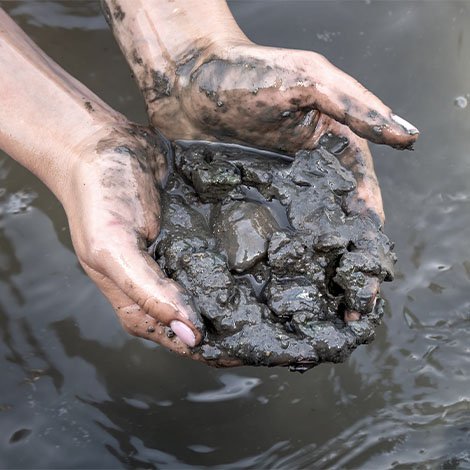
Muck Reduction
What is muck?
The bottom of a lake is made up of a mix of different materials and usually consists of varying amounts of inorganic and organic matter. Inorganic matter, such as boulders, rocks, gravel, sand or clay, can be present from the time of the lakes’ formation or get washed in from the surrounding land. Organic matter, commonly referred to as “muck”, consists of decomposing plant material from in-lake or surrounding vegetation, algae, fish waste or other biologic matter. Said another way, muck is natural.
Over time, organic matter settles to the bottom where it can accumulate to form thick layers. This tends to happen primarily in calmer areas, such as coves, depressions, and deeper parts of lakes. It is a normal part of lake ageing and, in and of itself, is not bad. Actually, a little muck, in the right places, is a very good thing since it helps support a wide variety of insect larvae, worms, snails, and other species that are critical to a healthy-lake food chain.
While muck is present in both lakes at Twin Lakes, it is primarily found at thicknesses of between 1 or 2 feet, except at deeper portions of the lakes and in areas where there is an increased amount of blown leaf litter and vegetation. In these areas, we can have more than 4 feet of muck, and a person could get stuck right up to their waist.
So, why do people think muck is bad?
Unfortunately, like most parts of life, too much of a good thing can become a bad thing. When muck buildup becomes excessive, it essentially begins to rot on the lake bottom. As bacteria start to consume this organic matter, they also consume oxygen. With the oxygen decreasing, the helpful critters that once lived in the muck must leave.Moreover, the lack of oxygen allows for the release of nutrients, such as phosphorous and nitrogen, that were bound to particles in the muck. The relative increase in these nutrient levels can fuel algae growth, and the potential for harmful agal blooms increases.
What causes muck levels to go from good to bad?
A healthy lake thrives on diversity. However, the introduction of invasive plants can throw this delicate balance into disarray. These plants, often lacking natural predators, grow rapidly and shed large amounts of plant matter, significantly increasing the organic material on the lakebed. Furthermore, their dense growth blocks sunlight, preventing native plants from thriving. This creates a vicious cycle: invasive plants flourish, drop more plant matter, and further deplete oxygen, leading to an unhealthy, mucky environment.
How can we prevent excessive muck development?
The best way to maintain a healthy balance of organic matter in a lake is to control invasive plant species and to minimize the addition of landside organic matter such as grass clippings, leaves, etc. This is one of the reasons that we advise against blowing material into the lake when landscaping. By harvesting curly leaf pond weed and other vegetation, we can reduce the amount of nutrients entering the lake and prevent adding to the accumulation of muck. This approach helps restore the lake’s ecological balance and promotes a diverse, thriving ecosystem.
“One of the best ways to promote a lake with a healthy level of organic matter is to keep invasive plants at a manageable level.”
How Can We Reduce Muck at Twin Lakes?
As with any problem, there is a large array of solutions on how to remove the muck from the lakes. Unfortunately, they are mostly cost prohibitive ranging from tens of thousands to hundreds of thousands of dollars for large scale applications of aeration, bacteria treatments, or dredging. To date, the TLPOA and TLWQC members have agreed that the level of muck present at the lake does not require these large-scale applications. However, there are many homeowners who wish to reduce the amount of muck present around their water-front area to improve the ability to walk into the lake and they have found that the addition of “Muck Pellets” has been effective when applied over the last few years.
It should be noted that to our knowledge, muck-reducing products have not been validated in peer-reviewed scientific literature. A mechanistic explanation by which pelleted bacteria consume and reduce organic matter is not available publicly, nor is a detailed composition of the pellets. Therefore, the recommendation for the application of muck pellets is purely based on the experiences and opinions of individual homeowners.
What Are Muck Pellets?
Muck pellets are a combination of natural beneficial bacteria, enzymes and vitamins that are designed to stimulate the biological activity at your lake bottom. They are all natural, do not contain herbicides or other harmful chemicals. These pellets sink and settle in the muck at the bottom of the lake and reportedly eat away at the muck by releasing beneficial bacteria and nutrients that thrive off of the organic material in the muck. While TLPOA and the TLWQC do not sponsor or have a formal recommendation on the pellets, below are links to pellets that some of your neighbors have used and have felt they were effective.
Air Max Via The Pond Website
Share Your Experience!
If you’ve used muck pellets around your waterfront, we’d love to hear about your experience - what worked, what didn’t, and any tips you’d offer others. Likewise, if you decide to try them this season, consider documenting your results and sharing them with your TLWQC representative. Your insights help build a stronger, more informed community approach to lake care.
If you have any questions about the above, don’t hesitate to reach out to your local TLWQC representative.